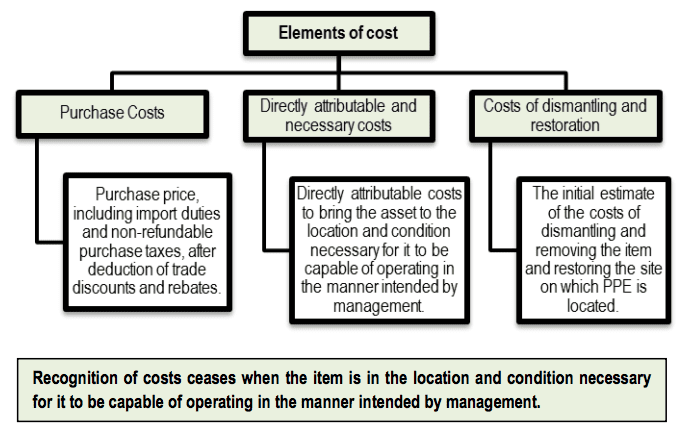Accounting Standard 10 (AS 10) – Accounting for Fixed Assets. The objective of this Standard is to prescribe the accounting treatment for property, plant, and equipment (PPE).
PPE are tangible items that:
- Are held for use in the production or supply of goods or services, for rental to others, or for administrative purposes; and
- Are expected to be used during more than a period of twelve months.
If you like this article then please like us on Facebook so that you can get our updates in the future ……….and subscribe to our mailing list ” freely “
Quick Links
Accounting Standard 10 (AS 10) – Property, Plant and Equipment
The cost of an item of PPE should be recognized as an asset if, and only if:
- (a) future economic benefits associated with the item will probably flow to the enterprise; and
- (b) the cost of the item can be measured reliably. Must Check Revenue Expenditure.
Measurement at recognition
At the time of recognition, an item of PPE that qualifies for recognition as an asset should be measured at its cost.

Examples of Directly Attributable Costs:
- Costs of employee benefits arising directly from the construction or acquisition of the item of PPE
- Costs of site preparation
- Initial delivery and handling costs
- Installation and assembly costs
- Professional fees
- Costs of testing whether the asset is functioning properly, after deducting the net proceeds from selling any items produced while bringing the asset to that location and condition (such as samples produced when testing equipment)
Exclusions:
- Administration and other general overhead costs
- Costs of opening a new facility or business, such as inauguration costs
- Costs of introducing a new product or service (including costs of advertising and promotional activities)
- Costs of conducting business in a new location or with a new class of customer (including costs of staff training)
PPE acquired in exchange for a non-monetary asset or assets, or a combination of monetary and non-monetary assets
The cost of such an item of PPE is measured at fair value unless:
- (a) the exchange transaction lacks commercial substance; or
- (b) the fair value of neither the asset(s) received nor the asset(s) given up is reliably measurable.
The acquired item(s) is/are measured in this manner even if an enterprise cannot immediately derecognize the asset given up. If the acquired item(s) is/are not measured at fair value, its/their cost is measured at the carrying amount of the asset(s) given up. You may also like Bridge Finance.

♣ Deferred Payment Plan
If an item of PPE is acquired under a deferred payment plan, the difference between cash price equivalent and total payment is recognized as interest throughout credit unless such interest is capitalized as per AS 16, Borrowing Costs.
Measurement after recognition
An enterprise should choose either the cost model or the revaluation model as its accounting policy and apply that policy to an entire class of PPE.

Accounting for Revaluations
- An increase in an asset’s carrying amount as a result of a revaluation is credited directly to owners’ interests under the heading of revaluation surplus. However, the increase should be recognized in the Statement of Profit and Loss to the extent it reverses a revaluation decrease of the same asset previously recognized in the Statement of Profit and Loss.
- A decrease in an asset’s carrying amount as a result of a revaluation is recognized in the Statement of Profit and Loss. However, the decrease should be debited directly to owners’ interests under the heading of revaluation surplus to the extent of any credit balance existing in the revaluation surplus in respect of that asset. You may also like Accounting Concepts and Conventions.
Depreciation
- Each part of an item of PPE with a cost that is significant to the total cost of the item should be depreciated separately.
- The depreciable amount should be allocated on a systematic basis over its useful life.
- The depreciation charge for each period should be recognized in the Statement of Profit and Loss unless it is included in the carrying amount of another asset.
- Residual value and useful life are to be reviewed at each balance sheet date. Any change is accounted for as a change in an accounting estimate as per AS 5.
- The depreciation method used should reflect the pattern in which the asset’s future economic benefits are expected to be consumed by the enterprise.
- Depreciation method to be reviewed at least at each financial year-end. Any change is accounted for as a change in an accounting estimate as per AS 5.
- Depreciation methods include SLM, WDV, and Units of Production method.
Retirements
Items of PPE retired from active use and held for disposal should be stated at the lower of their carrying amount and net realizable value. Any write-down should be recognized immediately in the Statement of Profit and Loss.
Derecognition
- The carrying amount of an item of PPE should be derecognized on disposal or when no future economic benefits are expected from its use or disposal.
- Gain/loss on derecognition should be recognized in the Statement of Profit and Loss (unless AS 19 requires otherwise in a sale and leaseback) and should not be classified as revenue.
- Gain/loss on derecognition is the difference between net disposal proceeds, if any, and the carrying amount of the derecognized item of PPE.

